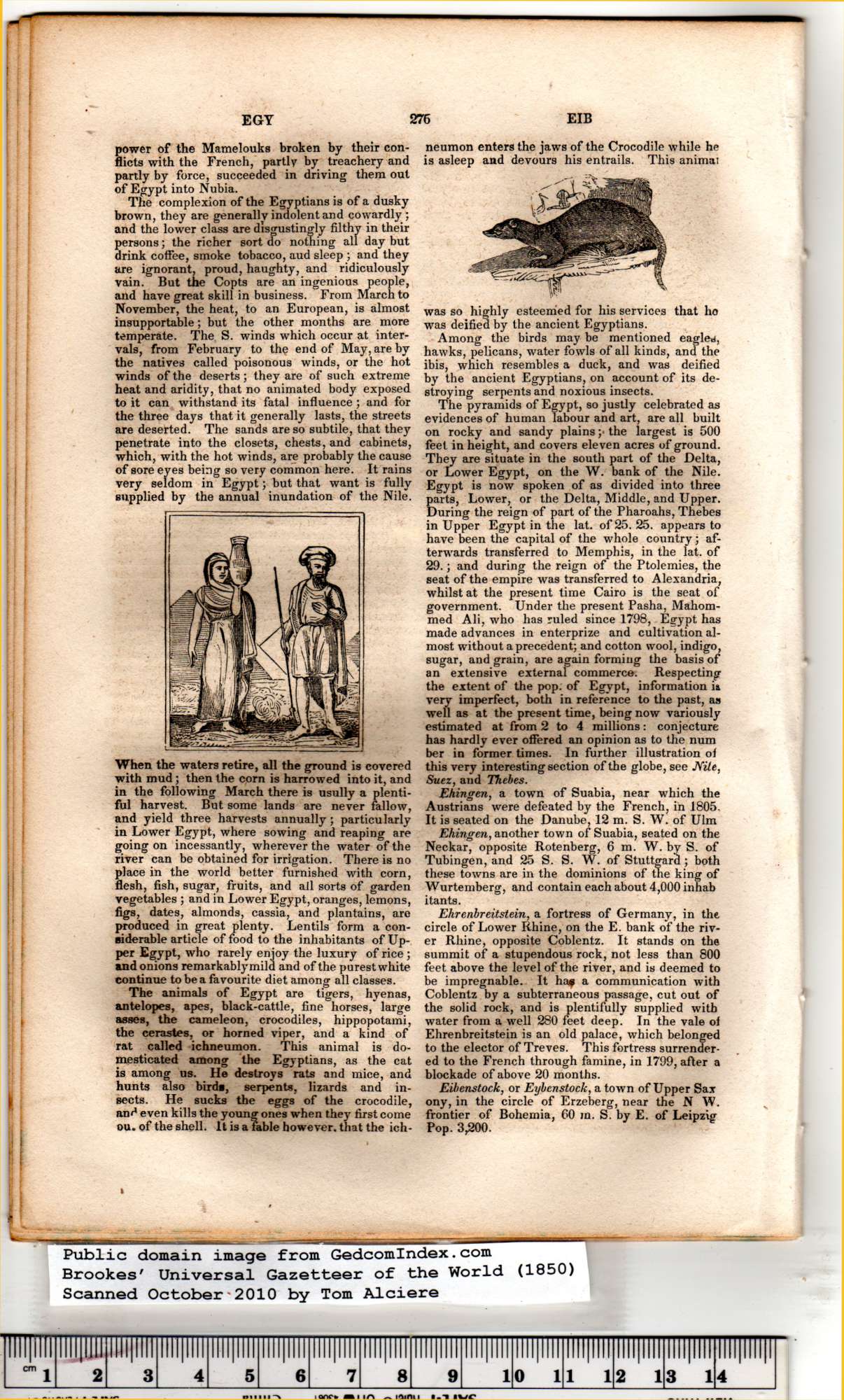|
power of the Mamelouks broken by their con-
flicts with the French, partly by treachery and
partly by force, succeeded in driving them out
of Egypt into Nubia.
The complexion of the Egyptians is of a dusky
brown, they are generally indolent and cowardly ;
and the lower class are disgustingly filthy in their
persons; the richer sort do nothing all day but
drink coffee, smoke tobacco, aud sleep ; and they
are ignorant, proud, haughty, and ridiculously
vain. But the Copts are an ingenious people,
and have great skill in business. From March to
November, the heat, to an European, is almost
insupportable; but the other months are more
temperate. The S. winds which occur at inter-
vals, from February to the end of May, are by
the natives called poisonous winds, or the hot
winds of the deserts; they are of such extreme
heat and aridity, that no animated body exposed
to it can withstand its fatal influence ; and for
the three days that it generally lasts, the streets
are deserted. The sands are so subtile, that the}'
penetrate into the closets, chests, and cabinets,
which, with the hot winds, are probably the cause
of sore eyes being so very common here. It rains
very seldom in Egypt; but that want is fully
supplied by the annual inundation of the Nile.
neumon enters the jaws of the Crocodile while he
is asleep and devours his entrails. This animal
When the waters retire, all the ground is covered
with mud; then the corn is harrowed into it, and
in the following March there is usully a plenti-
ful harvest. But some lands are never fallow,
and yield three harvests annually; particularly
in Lower Egypt, where sowing and reaping are
going on incessantly, wherever the water of the
river can be obtained for irrigation. There is no
place in the world better furnished with corn,
flesh, fish, sugar, fruits, and all sorts of garden
vegetables ; and in Lower Egypt, oranges, lemons,
figs, dates, almonds, cassia, and plantains, are
produced in great plenty. Lentils form a con-
siderable article of food to the inhabitants of Up-
per Egypt, who rarely enjoy the luxury of rice;
and onions remarkably mild and of the purest white
continue to be a favourite diet among all classes.
The animals of Egypt are tigers, hyenas,
antelopes, apes, black-cattle, fine horses, large
asses, the cameleon, crocodiles, hippopotami,
the cerastes, or horned viper, and a kind of
rat called ichneumon. This animal is do-
mesticated among the Egyptians, as the cat
is among us. He destroys rats and mice, and
hunts also birds, serpents, lizards and in-
sects. He sucks the eggs of the crocodile,
and even kills the young ones when they first come
ou. of the shell. It is a table however, that the ich-
was so highly esteemed for his services that ho
was deified by the ancient Egyptians. |
Among the birds may be mentioned eagles,
hawks, pelicans, water fowls of all kinds, and the
ibis, which resembles a duck, and was deified
by the ancient Egyptians, on account of its de-
stroying serpents and noxious insects.
The pyramids of Egypt, so justly celebrated as
evidences of human labour and art, are all huilt
on rocky and sandy plains; the iargest is 500
feet in height, and covers eleven acres of ground.
They are situate in the south part of the Delta,
or Lower Egypt, on the W. bank of the Nile.
Egypt is now spoken of as divided into three
parts, Lower, or the Delta, Middle, and Upper.
During the reign of part of the Pharoahs, Thebes
in Upper Egypt in the lat. of 25. 25. appears to
have been the capital of the whole country; af-
terwards transferred to Memphis, in the lat. of
29.; and during the reign of the Ptolemies, the
seat of the empire was transferred to Alexandria,
whilst at the present time Cairo is the seat of
government. Under the present Pasha, Mahom-
med Ali, who has ruled since 1798, Egypt has
made advances in enterprize and cultivation al-
most without a precedent; and cotton wool, indigo,
sugar, and grain, are again forming the basis of
an extensive external commerce. Respecting
the extent of the pop. of Egypt, information i&
very imperfect, both in reference to the past, as
well as at the present time, being now variously
estimated at from 2 to 4 millions: conjecture
has hardly ever offered an opinion as to the num
her in former times. In further illustration ol
this very interesting section of the globe, see JVile,
Suez, and Thebes.
Ehingen, a town of Suabia, near which the
Austrians were defeated by the French, in 1805.
It is seated on the Danube, 12 m. S. W. of Ulm
Ehingen, another town of Suabia, seated on the
Neckar, opposite Rotenberg, 6 m. W. by S. of
Tubingen, and 25 S. S. W. of Stuttgara; both
these towns are in the dominions of the king of
Wurtemberg, and contain each about 4,000 inhab
itants.
Ehrenbreitstein, a fortress of Germany, in the
circle of Lower Rhine, on the E. bank of the riv-
er Rhine, opposite Coblentz. It stands on the
summit of a stupendous rock, not less than 800
feet above the level of the river, and is deemed to
be impregnable. It ha* a communication with
Coblentz by a subterraneous passage, cut out of
the solid rock, and is plentifully supplied with
water from a well 280 feet deep. In the vale ol
Ehrenbreitstein is an old palace, which belonged
to the elector of Treves. This fortress surrender-
ed to the French through famine, in 1799, after a
blockade of above 20 months.
Eibenstoek, or Eybenstock, a town of Upper Sax
ony, in the circle of Erzeberg, near the N W.
frontier of Bohemia, 60 in. S. by E. of Leipzig
Pop. 3,200. |
